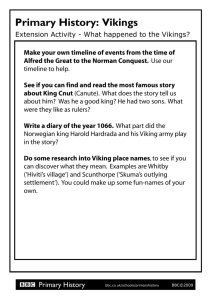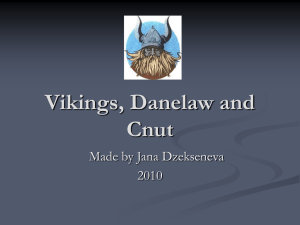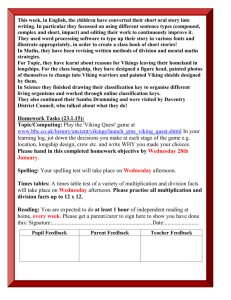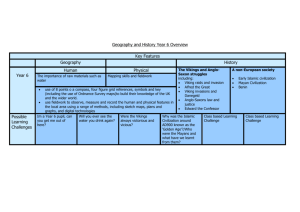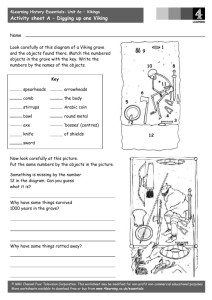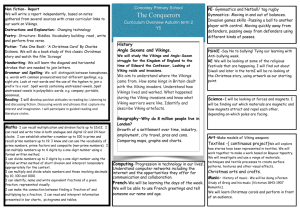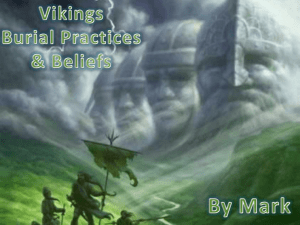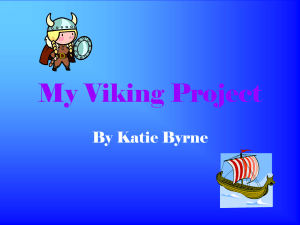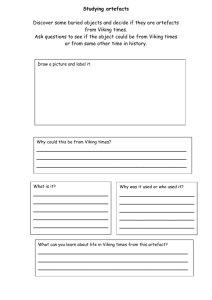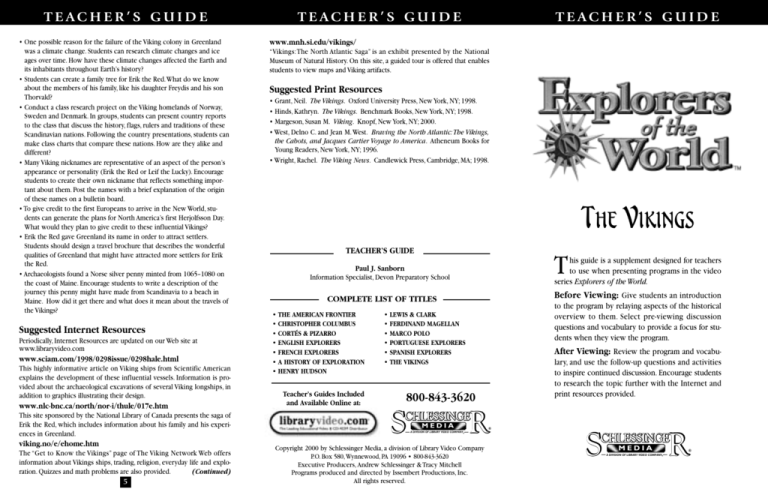
TEACHER’S GUIDE
• One possible reason for the failure of the Viking colony in Greenland
was a climate change. Students can research climate changes and ice
ages over time. How have these climate changes affected the Earth and
its inhabitants throughout Earth’s history?
• Students can create a family tree for Erik the Red.What do we know
about the members of his family, like his daughter Freydis and his son
Thorvald?
• Conduct a class research project on the Viking homelands of Norway,
Sweden and Denmark. In groups, students can present country reports
to the class that discuss the history, flags, rulers and traditions of these
Scandinavian nations. Following the country presentations, students can
make class charts that compare these nations. How are they alike and
different?
• Many Viking nicknames are representative of an aspect of the person’s
appearance or personality (Erik the Red or Leif the Lucky). Encourage
students to create their own nickname that reflects something important about them. Post the names with a brief explanation of the origin
of these names on a bulletin board.
• To give credit to the first Europeans to arrive in the New World, students can generate the plans for North America’s first Herjolfsson Day.
What would they plan to give credit to these influential Vikings?
• Erik the Red gave Greenland its name in order to attract settlers.
Students should design a travel brochure that describes the wonderful
qualities of Greenland that might have attracted more settlers for Erik
the Red.
• Archaeologists found a Norse silver penny minted from 1065–1080 on
the coast of Maine. Encourage students to write a description of the
journey this penny might have made from Scandinavia to a beach in
Maine. How did it get there and what does it mean about the travels of
the Vikings?
Suggested Internet Resources
Periodically, Internet Resources are updated on our Web site at
www.libraryvideo.com
www.sciam.com/1998/0298issue/0298hale.html
This highly informative article on Viking ships from Scientific American
explains the development of these influential vessels. Information is provided about the archaeological excavations of several Viking longships, in
addition to graphics illustrating their design.
www.nlc-bnc.ca/north/nor-i/thule/017e.htm
This site sponsored by the National Library of Canada presents the saga of
Erik the Red, which includes information about his family and his experiences in Greenland.
viking.no/e/ehome.htm
The “Get to Know the Vikings” page of The Viking Network Web offers
information about Vikings ships, trading, religion, everyday life and exploration. Quizzes and math problems are also provided.
(Continued)
5
TEACHER’S GUIDE
TEACHER’S GUIDE
www.mnh.si.edu/vikings/
“Vikings:The North Atlantic Saga” is an exhibit presented by the National
Museum of Natural History. On this site, a guided tour is offered that enables
students to view maps and Viking artifacts.
Suggested Print Resources
• Grant, Neil. The Vikings. Oxford University Press, New York, NY; 1998.
• Hinds, Kathryn. The Vikings. Benchmark Books, New York, NY; 1998.
• Margeson, Susan M. Viking. Knopf, New York, NY; 2000.
• West, Delno C. and Jean M.West. Braving the North Atlantic: The Vikings,
the Cabots, and Jacques Cartier Voyage to America. Atheneum Books for
Young Readers, New York, NY; 1996.
• Wright, Rachel. The Viking News. Candlewick Press, Cambridge, MA; 1998.
THE VIKINGS
TEACHER’S GUIDE
T
his guide is a supplement designed for teachers
to use when presenting programs in the video
series Explorers of the World.
Paul J. Sanborn
Information Specialist, Devon Preparatory School
Before Viewing: Give students an introduction
COMPLETE LIST OF TITLES
• THE AMERICAN FRONTIER
• CHRISTOPHER COLUMBUS
• CORTÉS & PIZARRO
• ENGLISH EXPLORERS
• FRENCH EXPLORERS
• A HISTORY OF EXPLORATION
• HENRY HUDSON
Teacher’s Guides Included
and Available Online at:
to the program by relaying aspects of the historical
overview to them. Select pre-viewing discussion
questions and vocabulary to provide a focus for students when they view the program.
• LEWIS & CLARK
• FERDINAND MAGELLAN
• MARCO POLO
• PORTUGUESE EXPLORERS
• SPANISH EXPLORERS
• THE VIKINGS
After Viewing: Review the program and vocabulary, and use the follow-up questions and activities
to inspire continued discussion. Encourage students
to research the topic further with the Internet and
print resources provided.
800-843-3620
CHLESSINGE
S
MEDIA
A DIVISION OF LIBRARY VIDEO COMPANY®
R
Copyright 2000 by Schlessinger Media, a division of Library Video Company
P.O. Box 580,Wynnewood, PA 19096 • 800-843-3620
Executive Producers, Andrew Schlessinger & Tracy Mitchell
Programs produced and directed by Issembert Productions, Inc.
All rights reserved.
®
S
R
CHLESSINGE
MEDIA
A DIVISION OF LIBRARY VIDEO COMPANY®
®
Historical Overview
The Vikings are now credited with the European discovery of North America
almost 500 years before Columbus made his voyages to the Caribbean. In the
9th century,Viking colonists had settled Iceland, and these brave, seafaring
people began to look west for new areas to colonize. Erik the Red, Bjarni
Herjolfsson and Leif Erikson traveled beyond the safety of the known lands of
Scandinavia and braved the frigid waters of the North Atlantic in their technologically advanced longships.Viking expeditions from Greenland explored
the coast of modern-day Canada in the areas of Baffin Island and Labrador.
Viking colonies lasted for almost 400 years in these forbidding climates.The
cold weather, poor relations with native people and great distances involved
in travel from Europe to North America are some of the theories that attempt
to explain why the Vikings didn’t move further south and establish more
permanent settlements in North America.
Time Line
c.970 — Leif Erikson is born.
c.980 — Erik the Red is banished from Iceland.
c.982 — Erik the Red founds Greenland.
c.986 — Settlers arrive in Greenland. Bjarni Herjolfsson travels from Europe
to the New World and sights Baffin Island and Labrador.
c.1000 — Leif Erikson travels from Greenland to Norway and meets with
King Olaf I Tryggvason.
c.1001 — Leif Erikson travels to the New World, following the example of
Herjolfsson and founds Vinland. Erik the Red dies in Greenland.
c.1020 — Leif Erikson dies.
c.1349 — The plague known as the Black Death strikes Europe.
c.1369 — The last trading ship from Europe comes to Greenland.
Vocabulary
Viking — An old Norse word for “pirate.”To go “a-viking” meant to leave
Norway, Sweden or Denmark after the spring planting and sail to other parts
of Europe in order to raid, trade and explore, returning home in time for the
fall harvest.
Norsemen — An alternate name for the Vikings that means “men from the
north” in modern English.
Vinland — Name for the settlement founded by Leif Erikson in the New
World.The exact location of Vinland is still debated, as is the meaning of the
name itself. Geographically,Vinland could have been located anywhere from
Massachusetts to Newfoundland.The name Vinland may have referred to the
presence of grapes or to the old Norse term for pasture.
Erik the Red — The father of Leif Erikson and the founder of the first
European settlement on Greenland.
(Continued)
2
banished — To be driven out or removed from a place. Erik the Red was
banished from his home in Iceland around 980 because he had killed a man.
eddas — The Viking sagas or long, narrative, written accounts of their
exploits as a people. Many eddas were written in the 1200s.
Greenland — An island in the Atlantic Ocean off the coast of northeast
North America.A European settlement on Greenland was founded by Erik the
Red around 982.
longships — Viking ships that were strong, sturdy and usually made of oak.
These vessels ranged in length from 45 to 75 feet.They had a sail that could
turn in any direction and was made of wool.These boats could also be rowed
if the wind wasn’t blowing.
Olaf I Tryggvason — (c.964–1000) The Viking king of Norway from
around 995 to his death; he attempted to bring Christianity to Norway.
Bjarni Herjolfsson — A Viking who was the first European to sight North
America around 986.
Snorri — The first child of European parents to be born in the New World.
Skraelings — The Viking name for native people of North America with
whom they came into contact.The origin of this term is debated but may
refer to animals that make strange and incomprehensible sounds. It is definitely an unflattering term for the Native Americans to whom it was applied.
plague — A contagious disease with a high rate of mortality.The plague
called the Black Death spread across Europe between 1347 and 1351, and
killed millions of people.
Pre-viewing Discussion
• Encourage students to list what comes to mind when they hear the term
“Viking,” and place the list of student contributions on the board for
further discussion. Are these terms mostly positive or negative representations of these people?
• The Vikings are known for their intense desire to explore and travel
around the world. Have students discuss what possible reasons Vikings
may have had for exploring way beyond the boundaries of their homelands.What would it take for students to leave their homes to live in a
place they had never been?
• Have students debate who the first Europeans were to reach the New
World.
• On a world map, identify the lands where Vikings lived.What can students
determine about the lands of the Vikings from the map?
Focus Questions
1.According to recent historical and archaeological investigations, who were
the first Europeans to reach the Western Hemisphere?
2.What does the term “Viking” mean?
3.What are eddas? Why are they important to understanding Viking history?
4.Where in Europe did the Vikings come from?
(Continued)
3
5.What role did Erik the Red play in the Viking explorations?
6. Describe the Viking longships.
7.Why was Bjarni Herjolfsson important to the discovery of the New
World?
8.Why did Leif Erikson name his colony in North America “Vinland”?
9.Who were the Skraelings?
10.What is Snorri’s significance in Viking settlement in the New World?
11.What was life like for the Vikings in Greenland when the two settlements there were at their peak?
12.Why did the Vikings ultimately leave Greenland?
Follow-up Discussion
• Have students discuss what aids and skills the Vikings had that enabled
them to sail westward from Scandinavia to the Western Hemisphere.
• The Vikings had great difficulty in their diplomacy with the native
people of North America. Have students brainstorm what the Vikings
could have done to improve their relationships with the local people.
Students can also debate whether it was necessary for the Vikings to
have good, positive relationships with native people.
• Have students discuss what conditions (climatic, physical, economic,
social, danger) might have prohibited the Vikings from settling further
south in permanent colonies in North America.
• Students can discuss why Columbus traditionally receives credit for
discovering the Americas, instead of Vikings like Herjolfsson or Erikson.
Follow-up Activities
• Viking longships provided the key for the Vikings’ success in exploration. Have students research these ships and, in groups, build their
own model longship marked with appropriate Viking symbols.
• Have a Viking festival! Students can research Viking food, clothing, coins
and artwork, and re-create the Age of the Vikings right in your classroom! Invite family members or other classes to take part in your festival to share what students have learned.
• Have students map out the routes of exploration used by Erik the Red
and Leif Erikson. Use this map as classroom illustration for reference.
• Read sagas written by Vikings to determine the common elements and
themes contained in these written accounts. (See sunsite.berkeley.edu/
OMACL/Heimskringla/ for a collection of Norse sagas.) Using the Viking
sagas as models, students can write their own sagas, detailing imagined
feats of bravery.
• Students can research Viking gods like Odin, Loki and Thor. See Odin’s
Family: Myths of the Vikings by Neil Philip (Orchard Books, 1996) for
more information about these gods.These traditional myths of the gods
can be acted out in class plays.
(Continued)
4

